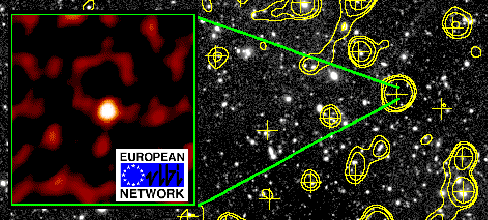Pin-Pointing Black Holes in Distant Galaxies
Uupgraded European Network of Radio Telescopes has Sharper Vision than Hubble
30 January 2001

CAPTION: The faintest radio sources ever detected using high resolution Very Long Baseline Interferometric techniques - EVN images of radio sources detected in the Hubble Deep Field. These images are overlayed upon a radio contour map of the region produced by the Westerbork Radio Telescope (yellow contours), which is itself superimposed upon a deep optical image of the HDF region made by the Canada-France-Hawaii telescope (courtesy Amy Barger et al).
The most detailed images ever made of faint, distant radio galaxies, located billions of light years from Earth, reveal that many of them harbour central massive black holes, adding further support to the belief that super-massive black holes are inextricably linked with the way galaxies formed in the early universe. Because the radio images are three times sharper than those from the Hubble Space Telescope, the new pictures (see http://www.nfra.nl/~mag/hdf/evn/pr/) give a fresh insight into what is happening in the centre of some of these galaxies. The images, generated by the recently upgraded European VLBI Network (EVN) are particularly valuable because they penetrate the dust that often blocks the view of even the most powerful optical telescopes.
The pioneering observations were conducted by an international team of radio astronomers from Europe and the USA. The radio signals were received by the giant 100-m telescope in Effelsberg, Germany; the 76-m Lovell Telescope in the UK, the 70-m NASA/DSN antenna near Madrid in Spain, and six other large radio telescopes located across Europe. Data at each of the radio telescopes were archived on high speed magnetic tape recorders, generating almost 25000 Gigabytes of data in total. By means of a special, purpose-built super-computer (operated by the National Radio Astronomy Observatory in Socorro, USA), the magnetic tapes were later played back and combined together to form a super-sensitive, giant radio telescope of continental dimensions.
For this experiment, the network was focussed on a small region of sky devoid of bright, nearby stars or local galaxies, a sort of window on the distant universe. Since the Hubble Space Telescope peered at this same region, this otherwise unremarkable patch of sky has become famous as the 'Hubble Deep Field' and is now known to contain thousands of galaxies. The scientific team that initiated the new radio observations is led by Dr. Michael Garrett of the Joint Institute for VLBI in Europe, Dwingeloo, the Netherlands (JIVE), together with Drs. Simon Garrington and Tom Muxlow of the MERLIN National Facility, Jodrell Bank Observatory, UK. Three radio sources were detected in an area of sky no bigger than that covered by a grain of sand held up to the night sky. The results appear in the latest issue of the European journal, Astronomy and Astrophysics.
According to Garrett the team had not expected to detect this many radio sources. "Even this is a large area of sky for a high resolution radio instrument like the EVN - imaging such a large field so deeply and at such high resolution is something of a first for VLBI, and detecting three very faint radio sources is a bit like going shopping in the winter sales, and getting 3 items for the price of 1!" he said. But it is not just the number of radio sources detected that took the team by surprise but also the diversity of galaxy type hosting them. "Our three radio sources are identified with a broad range of galaxy type: an elliptical galaxy, a spiral galaxy and a very distant, dust obscured starburst galaxy", said Garrett.
But for Simon Garrington and Tom Muxlow (MERLIN/Jodrell Bank) the real surprise is that the sources are so small (less than 600 light-years across). "This clearly suggests that the radio emission is generated by a powerful central engine, associated with a super-massive black hole" said Garrington. Astronomers had previously thought that the radio emission from these distant galaxies would come from the numerous remnants of short-lived massive stars. Indeed, this rapid churning of material in the galaxy produces cosmic dust which glows at infra-red wavelengths but is impenetrable to all but radio and sub-millimeter telescopes. "These high resolution radio observations are crucial in distinguishing between galaxies which contain massive black holes and those that are powered purely by star-formation processes" said Prof. Ken Kellermann (NRAO, USA) another member of the team.
"This has been a model of international collaboration and a massive effort by the scientific team itself - these are the faintest radio sources ever to be detected by the VLBI technique" says, Prof. Richard Schilizzi, director of JIVE.
Contacts for this release:
Dr. Michael Garrett, Joint Institute for VLBI in Europe (JIVE),
Postbus 2, 7990 AA Dwingeloo, the Netherlands.
E-mail: garrett@jive.nl
Phone: +31 (0) 521 596511
Drs. Thomas Muxlow and Simon Garrington,
Jodrell Bank Observatory, University of
Manchester, UK.
E-mail: twbm@jb.man.ac.uk and stg@jb.man.ac.uk
Phone: +44 (0) 1477 571321
Additional information: High resolution images are available at http://www.jive.nl/~mag/hdf_evn/pr. Images of the EVN telescopes and their location, plus details of how to contact members of the scientific team are also available at this www address. For more general information about the EVN and JIVE consult http://www.jive.nl


